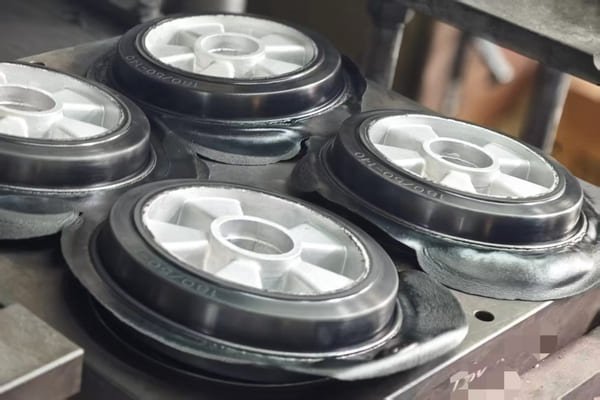Having helped numerous clients transition from sampling to mass production, I've seen how crucial understanding these differences is. Making the wrong assumptions can lead to costly surprises.
Sample molds and mass production molds differ primarily in design complexity, durability, cavity count, and automation level. Production molds cost 5-10 times more but offer higher efficiency and consistent quality.

I run both options in my factory. I start lean with proof, then I scale with confidence. This approach protects budgets and delivery dates for B2B buyers.
What is a sample mold and when should I use it?
Bad surprises appear late if I skip early validation. A sample mold brings them forward when changes are cheap.
A sample mold is a simpler, faster tool with few cavities and flexible inserts. I use it to prove dimensions, assembly fit, sealing performance, and cure windows before I invest in hardened multi-cavity tools.
I design sample molds1 with one to four cavities. I keep steel “safe” on risky dimensions so I can polish down if the first articles2 run big. I select pre-hardened steels3 like P20 or NAK to shorten machining time without sacrificing surface quality. I cut micro-vents4 at last-fill areas to release trapped air and to avoid burn marks. I often gate directly to the part to simplify flow and improve dimensional learning5, even if the future production mold will use a more complex runner.
I plan the experiment. I run a short DOE on temperature, pressure, and cure time. I document the window that holds dimensions and hardness. I send a compact PPAP-lite6: drawing DFM notes, material certificate, hardness report (ASTM D2240 with dwell and temperature), dimensional report on CTQ features, and photos of surface and parting-line quality. If the application is HVAC sealing7, I add compression-set and leak tests on request.
I remember one thin-lip gasket that failed a torque test8 in assembly. I revised the land by 0.1 mm, added a vent near the weld line, and slightly increased cure time. The next build passed with margin. That small, fast change saved weeks compared to reworking a hardened production tool.
What is a mass production mold9 and when does it make sense?
High volume demands repeatable output and low cost per piece. Guesswork does not belong here.
A mass production mold is a hardened, multi-cavity tool with balanced runners, robust cooling, and tight process control. I switch after data is stable and demand justifies the investment.

I build production molds in H13/SKD61 or similar steels. I harden, grind, and polish to the finish the part needs. I design balanced runners and optimized gates to reduce shear and keep weld lines away from sealing edges. I use vent depths that hold flash thin but still release air. I add cooling or heating channels when the press requires rapid thermal recovery. I size flash lands to maintain edge quality over long runs.
I scale cavities to the takt time. Four to thirty-two cavities are common, depending on part size and press tonnage. I protect dimensional stability with process sheets and tooling maintenance plans. I schedule vent cleaning10, surface checks, and insert inspections after defined shot counts11. I run capability studies (Cp/Cpk) on CTQ dimensions12 when programs ask for it. I tie each lot to a material batch with EN 10204 3.1 certificates.
I move to production only after first articles pass, process windows are proven, and assembly tests show margin. I also want a stable forecast. This timing keeps the unit cost low and the scrap rate lower.
How do cost, lead time, and risk compare?
Tooling decisions shape the whole project. I balance speed, cash, and certainty.
Sample molds cost less and arrive faster. They reduce design risk. Production molds cost more and take longer. They reduce unit price and improve throughput.
High-level comparison
| Factor | Sample Mold | Mass Production Mold |
|---|---|---|
| Typical Cavities | 1–4 | 4–32+ |
| Steel | P20/NAK (pre-hardened) | H13/SKD61 (hardened) |
| Lead Time | ~2–4 weeks | ~4–10+ weeks |
| Design Flexibility | High (easy rework) | Low (changes costly) |
| Unit Cost | Higher | Lower |
| Risk Reduction | Excellent for design/process | Excellent for scale/capability |
| Ideal Use | Validation, bridge runs | Long-term volume |
📌 What drives cost and time
I shorten sample-mold time by using standard mold bases, simple runners, and minimal texturing. I compress the machining queue with pre-hardened inserts and fewer electrodes. For production molds, I add effort to runner balance13, thermal design14, hardened surfaces, and multi-cavity flow simulation when needed. This care upfront saves cost per piece and stabilizes capability in steady state.
⚠️ Risk strategy
I treat a sample mold like an insurance policy. It finds tolerance traps, demold issues, and air entrapment while changes are cheap. Once stable, I scale with a high-cavity tool, confident that I will not engrave defects into expensive steel.
How do tolerances, surface, and lifespan differ?
Precision and life expectancy come from material, finish, and maintenance. I set expectations early.
Sample molds achieve drawing compliance but prioritize agility. Production molds aim for tighter repeatability, better surface durability, and long tool life under real cycle counts.
🎯 Tolerance control
I mark drawings with DIN ISO 3302-1 classes. I typically aim M2 for sealing features and M3 for large, simple profiles. Sample molds hold these classes, but they tolerate more insert rework and polishing. Production molds target the same classes with better repeatability because of hardened surfaces, stable runner balance, and better thermal control.
✨ Surface finish
Sample tools often receive functional polishes only. I avoid expensive textures until geometry is frozen. Production tools can carry higher cosmetic finishes and laser engravings. These choices resist wear in long campaigns and keep edges crisp.
🧱 Tool life and maintenance
Pre-hardened sample inserts handle dozens to a few thousand shots with good care. Hardened production tools run tens to hundreds of thousands of shots with scheduled maintenance. I clean vents and re-polish lands on a cycle. I track shot counts11 and scrap triggers. This plan prevents burr growth and keeps flash within limits.
🧪 Quick reference
| Topic | Sample Mold | Mass Production Mold |
|---|---|---|
| Tolerance Stability | Good | Very good to excellent |
| Surface Wear | Faster | Slower |
| Flash Control Over Time | Drifts sooner | Holds longer |
| Maintenance Interval | Short | Longer, but planned |
| Expected Shot Life | Low–medium | Medium–high |
How do gating, venting, and flash strategies change?
Flow and air control decide part quality. I tune them differently for learning vs volume.
Sample molds favor simple, visible flow paths and generous, controllable vents for learning. Production molds favor balanced runners, optimized gates, and vent depths that hold flash thin for long campaigns.
Gating
In sample molds1, I often gate directly to the part or use a short runner. This reveals knit lines and last-fill zones fast. In production, I balance runner lengths and gate sizes across cavities to equalize fill. I place weld lines away from sealing lips. I size gates to avoid jetting and over-shear, which can hurt surface and mechanical properties.
Venting
I cut micro-vents4 at last-fill areas. In sample tools, I may start slightly deeper to ensure learning and then close them down as data improves. In production tools, I set vent depth to a tighter band so flash remains thin over time. I add vacuum assistance when parts trap air easily.
Flash land
I tune land width and depth during trials. Too narrow starves fill; too wide increases flash and trim cost. In production, I lock the land that delivers capability while keeping maintenance practical.
When should I switch from a sample mold to a production mold?
Switch too early and I pay to fix expensive steel. Switch too late and I miss delivery windows.
I move to production when first articles pass, process windows are stable, assembly tests have margin, and volume justifies multi-cavity investment.
✅ My green-light checklist
- CTQ dimensions meet spec over multiple press runs
- Hardness and compression-set meet targets with the chosen cure system
- Assembly, leak, or torque tests pass with margin
- Weld lines and parting-line quality meet customer requirements
- Scrap is low and stable; vents and lands are proven
- Forecast supports the ROI on multi-cavity hardened steel
🧭 Transition plan
I freeze the geometry. I finalize the runner and gate strategy. I update the control plan and gage list. I define preventive maintenance for the production tool. I build safety stock during ramp-up if the project is time-critical. This plan makes the first mass-production shipment look like the tenth.
Can a sample mold support bridge production?
Buyers often need parts while the big tool is in build. I plan for that with eyes open.
Yes. A well-built sample mold can produce dozens to a few thousand parts as a bridge. I monitor vent cleanliness, flash land condition, and dimensional drift to protect quality.

I define a maximum shot count for bridge runs. I schedule vent cleaning and edge touch-ups at fixed intervals. I maintain the same material lot strategy used in validation. I hold the same press settings and cure window. I document each lot with dimensional spot-checks on CTQ features. If demand exceeds the bridge plan, I pull forward the production tool or duplicate the sample tool to split risk.
Practical guardrails
| Item | Guardrail | Reason |
|---|---|---|
| Shot Count | Predefined cap | Avoids drift into unstable wear |
| QC Sampling | CTQ spot-check each lot | Detects early deviations |
| Maintenance | Vent clean and land polish | Keeps flash and dimensions stable |
| Change Control | Geometry freeze | Prevents revalidation loops |
What should I send you to choose the right path?
Good inputs make fast, correct decisions. I keep the intake simple.
Send me your 2D drawing with tolerance class and CTQ notes, the 3D STEP, rubber type and hardness, and your first-article test plan. I will propose sample or production tooling with a clear schedule and cost.
My quick-start checklist
- 2D drawing with DIN ISO 3302-1 class and hardness spec (ASTM D2240, dwell, temp)
- 3D STEP15 for split-line and shrink strategy
- Rubber family and cure system (EPDM/NBR/HNBR/FKM/VMQ; peroxide/platinum)
- First-article tests (compression set, leak, tensile, aging)
- Forecast and target launch date; bridge-run needs if any
- Incoterms and ship-to country for planning
Work with me
- 📩 Email: info@rubberandseal.com
- 🌐 Website: www.rubberandseal.com
- 🏭 Brand: Julong Rubber — China-based factory, B2B wholesale only
- 🧰 Products: rubber seals, custom rubber parts, rubber wheels, rubber tubes, rubber gaskets
- 🌍 Main export: Germany, France, the Netherlands
Conclusion
Choose between sample and production molds based on your volume requirements, quality needs, and budget constraints. Production molds offer better long-term value for high volumes, while sample molds suit prototype and low-volume needs.
-
Explore how sample molds can reduce design risk and improve production efficiency. ↩ ↩
-
Learn about the role of first articles in validating production processes. ↩
-
Learn about the benefits of using pre-hardened steels like P20 and NAK in mold design. ↩
-
Discover how micro-vents help in air release and improve part quality. ↩ ↩
-
Understand the importance of dimensional learning for optimizing mold designs. ↩
-
Find out how a PPAP-lite can streamline the production approval process. ↩
-
Explore the significance of HVAC sealing in ensuring system efficiency. ↩
-
Learn about the importance of torque tests in ensuring product reliability. ↩
-
Discover the characteristics and benefits of mass production molds. ↩
-
Discover the significance of vent cleaning for maintaining mold quality. ↩
-
Discover how shot counts influence mold maintenance and performance. ↩ ↩
-
Understand the critical-to-quality dimensions that impact product performance. ↩
-
Learn how runner balance affects the quality and efficiency of molded parts. ↩
-
Explore the role of thermal design in optimizing mold performance. ↩
-
Learn about the importance of 3D STEP files in mold design and production. ↩








